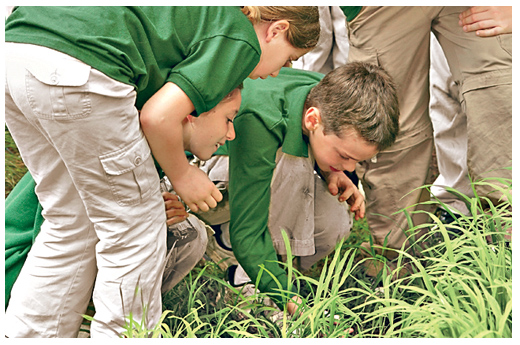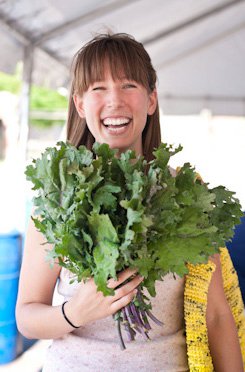 by Chelsey Simpson, communications associate for the National Farm to School Network
by Chelsey Simpson, communications associate for the National Farm to School Network
Most of us can remember a childhood encounter with chicken nuggets, Tater-Tots, and canned peaches in syrup as our lunch. But with one in three children currently considered overweight or obese, ideas about how we feed our kids at home and at school are changing, and many school cafeterias are leading the charge.
One of the most promising models for changing the way we feed kids is known as “farm to school,” and it involves connecting schools with fresh, locally grown food and food and agriculture education opportunities.
In my work with the National Farm to School Network I field questions from people all over the country who are trying to help kids gain access to healthy, locally sourced food at school. Farm-to-school programs exist in all 50 states and the District of Columbia, but there are still some common misconceptions. Here are the top 5 myths about farm-to school:
Myth #1: Farm-to-school is only about local food in the cafeteria.
Fact: Farm-to-school programs are as diverse as the communities that build them, and school gardening, nutrition education in the classroom, and even cooking lessons are equally important aspects of farm-to-school. While integrating local food into the school cafeteria is the goal of many farm-to-school programs, studies have shown that without complementary education, kids might not even try the new foods being offered. It’s also important to remember that most farm-to-school programs start small: Container gardens, local apple taste tests, and field trips to farms are all examples of common and successful farm-to-school activities.
Myth #2: My school is too small/big/urban/rural/underfunded to have a farm-to-school program.
Fact: Farm-to-school programs are taking shape in all kinds of communities, from schools with fewer than 100 students in rural Montana to large schools in big urban districts in cities like Chicago and New York. The key, again, is to remember farm-to-schools’ diversity and to do what you can, where you are, with what you have. Not enough money for a farm field trip? Start a farmer pen-pal program (farmers love to get letters from kids!). Supply problems thwarting your all-local salad bar? Buy a smaller quantity of cherry tomatoes in several varieties and let kids sample them to determine a favorite. Every program has to start somewhere!
Myth #3: Purchasing local food is too expensive, and my school can’t afford it.
Fact: Not necessarily. In some cases, studies have shown that the local option is NOT more expensive. For example, Michigan apples are very affordable during apple harvest season, and fish is often less expensive than beef in Alaska. There’s also the possibility that your school is already receiving some local products from its regular distributor, but the staff either doesn’t know it or isn’t advertising it. Asking is the first step. Finally, we can’t talk about cost without also talking about the link between food and health. Research shows that kids participating in farm-to-school programs eat as much as 1.3 additional servings of fruits and vegetables in their school meals and make healthier food choices at home, too. Spending a few extra cents on lunch today might save thousands of healthcare dollars down the road.
Myth #4: It’s illegal for schools to buy local food.
Fact: Farm-to-school is taking place at more than 12,000 schools in all 50 states, and the USDA has made it clear that schools are allowed to give preference to locally sourced food during the bid process. You can read more about the geographic preference rule here. Every state and school district does have its own set of additional guidelines, however, so it’s always best to check with someone locally to understand the lay of the land. The National Farm to School Network has state leads (aka, local experts) who can help you navigate your community’s regulations.
Myth #5: Someone else is going to start a program for you.
Fact: The two most common questions we receive at the National Farm to School Network are, “Where can I apply to get a farm-to-school program?” and “How does my school qualify to receive local food?” Both hint at the misconception that farm-to-school is something that comes from outside a community (like being selected for Extreme Home Makeover) versus inside the community (like a barn-raising.) So I’m here to tell you this is a movement of grassroots movers and shakers, barn raisers, and seed sowers! Virtually every farm-to-table program in the country was started by someone just like you. And don’t forget that we are here to help: In addition to contacting one of the National Farm to School Network’s local experts, check out our “Getting Started” guide and join our network so you can stay in touch. When your spuds have sprouted and your local hamburger is a hit, we want to hear about it!
 Chelsey Simpson is the Membership and Communications Associate at the National Farm to School Network. She lives in Oklahoma City where she volunteers at the Oklahoma Food Cooperative.
Chelsey Simpson is the Membership and Communications Associate at the National Farm to School Network. She lives in Oklahoma City where she volunteers at the Oklahoma Food Cooperative.




Thanks you for sharing this information. It’s always a mystery why anyone in this world would object to feeding our children good food. Our kids can’t learn and grow and be healthy, strong independent adults without good food as they grow and learn. It should be our country’s first priority!